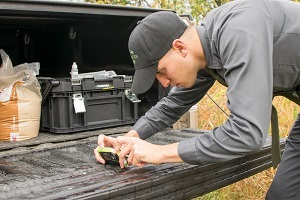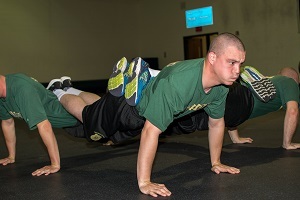Forensic science studies help recruits get a clue
Week 12: Oct. 1-7, 2017
With a detective’s curiosity and a scientist’s analytical approach, the recruit surveyed the “crime scene,” determined to coax it into surrendering clues.
Kneeling beside the motionless deer, his gloved hand gently lifted its head off the ground in a clinical manner. Determining how and when the deer died will establish whether a crime was committed, and as the recruit had just learned from his instructors earlier in the day, the constriction of eye pupils is one telltale sign that narrows the approximate time of death. manner. Determining how and when the deer died will establish whether a crime was committed, and as the recruit had just learned from his instructors earlier in the day, the constriction of eye pupils is one telltale sign that narrows the approximate time of death.
Was the animal illegally taken before the hunting season began? Was it killed outside of legal hunting hours? Or was it taken lawfully and still being tracked by the hunter?
Additional field tests confirmed his suspicion. The recruit then recorded his findings with his notebook and camera, hoping the evidence will lead to the arrest and conviction of the responsible poacher.
The scenario was one of several that challenged trainees as they entered the intricate world of forensic science during Week 12 of the Michigan Department of Natural Resources Conservation Officer Recruit School. It’s a multifaceted discipline that demands the savvy of a street cop, the instincts of an investigator and the meticulousness of a medical examiner.
Conservation officers must be skilled in the techniques of recognizing, collecting and preserving evidence. The  expertise is necessary not only for the enforcement of fish and game laws, but also because conservation officers often are first to arrive at accident and crime scenes. The lessons recruits absorbed throughout the week furthered their progression as front-line protectors of Michigan’s natural resources and citizens. expertise is necessary not only for the enforcement of fish and game laws, but also because conservation officers often are first to arrive at accident and crime scenes. The lessons recruits absorbed throughout the week furthered their progression as front-line protectors of Michigan’s natural resources and citizens.
Say ‘cheese’
After Monday’s early-morning physical training got their blood pumping, recruits got down to business with a forensic photography class led by retired Michigan State Police Lt. Eric Johnson. Forensic photography produces a permanent visual record of accident and crime scenes for use as evidence in court.
Conservation officers deal with crime scene conditions that may deteriorate quickly. For example, footprints can get covered with snow or washed away with heavy rain. It is important that recruits learn to effectively document evidence the first time since they may not get a second chance.
To assist them in capturing visual evidence, recruits were issued the waterproof Fujifilm XP cameras they will carry upon becoming conservation officers.
Building a case
Recruits spent Tuesday in legal training with retired Michigan State Police inspector David Greydanus. They learned  about rights under the Fifth and Sixth amendments to the Constitution, juvenile laws and interrogation procedures. about rights under the Fifth and Sixth amendments to the Constitution, juvenile laws and interrogation procedures.
On Wednesday, the class had the benefit of hearing from an internationally recognized expert in wildlife forensics. Dave Stephens, a professor at Michigan State University’s School of Criminal Justice, talked to recruits about gathering crime scene evidence, determining bullet trajectory and other skills. He was assisted by detectives from the DNR Law Enforcement Division’s Special Investigations Unit. Conservation officers document a wide array of evidence while working in the field, including DNA evidence in poaching situations.
CSI: Michigan
Recruits got the chance to get out of the classroom and soak up some early autumn sun Thursday. They left the academy grounds to participate in an evidence collection and  preservation scenario. Under the scenario, they responded to complaints of an abandoned deer carcass. preservation scenario. Under the scenario, they responded to complaints of an abandoned deer carcass.
Recruits found the carcass and conducted a variety of field tests to determine the time of the animal’s death. By taking the outside air temperature, along with the deer’s internal temperature and weight, recruits determined an approximate time of death. Recruits were encouraged to learn these skills well as they will be used frequently throughout their careers as conservation officers.
Another training session awaited the class Friday. Building on all the knowledge they gained throughout the week, recruits practiced responding to a “shots fired” complaint. Arriving at the scene, they found a pickup truck with an unloaded rifle and blood on the tailgate. Trainees then tracked a blood trail until they found the remains of a deer, where they collected and packaged DNA evidence.
Big responsibility
The forensics and ballistics training of Week 12 brought recruits closer to the everyday duties they will perform as conservation officers. As investigators and first responders, they will be responsible for securing accident and crime scenes, and gathering and protecting evidence that is the lifeblood of a fair, effective legal system. A big responsibility, indeed. Now it’s on to Week 13.
Subscribe to the weekly conservation officer academy blog, which also will be posted on the Michigan DNR Facebook page. View previous blogs from Recruit School #8.
/Note to editors: Accompanying photos are available below for download. Caption information follows.
Forensic_science: Solving criminal cases often depends on forensic evidence. Trainees in Week 12 of the Michigan Department of Natural Resources Conservation Officer Recruit School learned basic forensic techniques that will serve them well in the field.
Give_me_50!: Physical training keeps recruits in peak mental and physical condition. Pictured, trainees perform a series of “support pushups,” in which they put their extended legs over the backs of their partners, unlike the traditional pushup method.
Field_test: Conservation Officer Richard Stowe watches a recruit conduct field tests that will provide an approximate time of death for the deer. Much of Week 12 in the Michigan Department of Natural Resources Conservation Officer Recruit School was devoted to forensic science.
Collecting_evidence: Recruits run a swab over a vehicle door handle to gather forensic evidence necessary to build a legal case./
The Michigan Department of Natural Resources is committed to the conservation, protection, management, use and enjoyment of the state’s natural and cultural resources for current and future generations. For more information, go to www.michigan.gov/dnr.
|

 manner. Determining how and when the deer died will establish whether a crime was committed, and as the recruit had just learned from his instructors earlier in the day, the constriction of eye pupils is one telltale sign that narrows the approximate time of death.
manner. Determining how and when the deer died will establish whether a crime was committed, and as the recruit had just learned from his instructors earlier in the day, the constriction of eye pupils is one telltale sign that narrows the approximate time of death. expertise is necessary not only for the enforcement of fish and game laws, but also because conservation officers often are first to arrive at accident and crime scenes. The lessons recruits absorbed throughout the week furthered their progression as front-line protectors of Michigan’s natural resources and citizens.
expertise is necessary not only for the enforcement of fish and game laws, but also because conservation officers often are first to arrive at accident and crime scenes. The lessons recruits absorbed throughout the week furthered their progression as front-line protectors of Michigan’s natural resources and citizens.  about rights under the Fifth and Sixth amendments to the Constitution, juvenile laws and interrogation procedures.
about rights under the Fifth and Sixth amendments to the Constitution, juvenile laws and interrogation procedures. preservation scenario. Under the scenario, they responded to complaints of an abandoned deer carcass.
preservation scenario. Under the scenario, they responded to complaints of an abandoned deer carcass.




